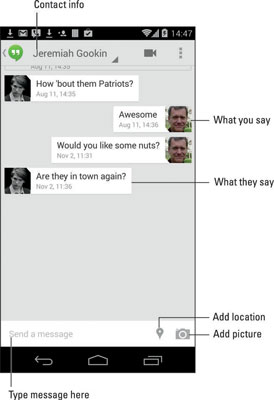

The new app launches a messaging app with an implicit intent, and passes a fixed phone number and a message entered by the user. In this task you create an app called PhoneMessaging, a new version of the PhoneCallDial app from a previous project. You will copy the app, rename it to SmsMessaging, and modify the layout to include another EditText for entering the message, and change the ImageButton to an icon that the user can tap to send the message. It checks for permission and then uses the SmsManager class to send the message.Īs shown in the figure below, the PhoneCallingSample app already has an EditText view for entering the phone number and an ImageButton for making a phone call.
#Android messages sending code#
PhoneMessaging: Rename and refactor the PhoneCallDial app from the previous chapter, and add code to enable a user to not only dial a hard-coded phone number but also send an SMS message to the phone number.You will create two new apps based on apps you created previously about making phone calls: Request permission from the user, if necessary, to send SMS messages.Check for the SMS permission, which can change at any time.Create an app that sends SMS messages using the SmsManager class.Pass data (the phone number) and the message with the implicit intent.Create an app that uses an implicit intent to launch a messaging app.Extract an SMS message from an SMS event.Receive SMS events using a broadcast receiver.Check for the SMS permission, and request permission if necessary.Send an SMS message from within an app.Launch an SMS messaging app from your app with a phone number and message.Use a broadcast receiver to receive system events.Use an implicit intent to perform a function with another app.Create an onClick method for a button with the android:onClick attribute.To receive SMS messages, use the onReceive() method of the BroadcastReceiver class. You can manage SMS operations such as dividing a message into fragments, sending a multipart message, get carrier-dependent configuration values, and so on.The user stays in your app during and after sending the message.Your app must ask the user for permission before sending the SMS message, if the user hasn't already granted permission.This is a good choice for sending messages from your app without having to use another installed app.Send the SMS message using the sendTextMessage() method or other methods of the SmsManager class.The user navigates back to your app using the Back button.The user can change the message in the messaging app before sending it.(Android smartphones will have at least one, such as Messenger.)
#Android messages sending android#
If the user has multiple SMS messaging apps installed on the Android phone, the App chooser will appear with a list of these apps, and the user can choose which one to use.Your app doesn't need code to request permission from the user.The user can add a picture or other attachment in the messaging app, if the messaging app supports adding attachments. This is the simplest choice for sending messages.Use an implicit Intent to launch a messaging app with the ACTION_SENDTO intent action.You have two choices for sending SMS messages: P 03.2: Sending and Receiving SMS Messages IntroductionĪndroid smartphones can send and receive messages to or from any other phone that supports Short Message Service (SMS).


 0 kommentar(er)
0 kommentar(er)
